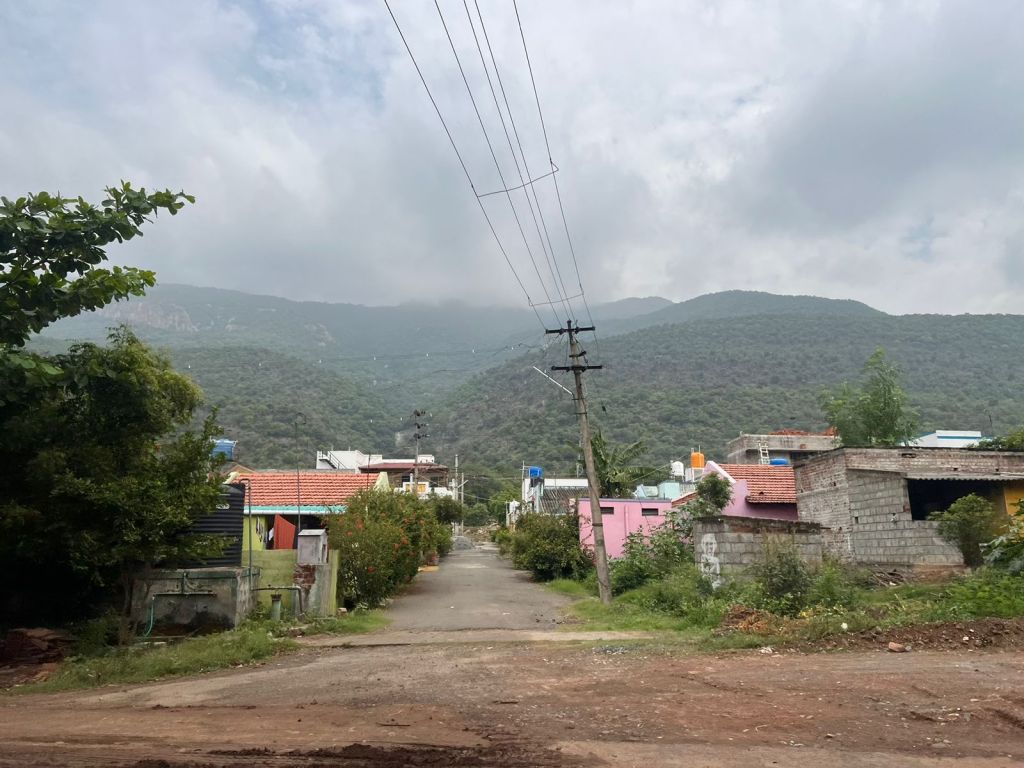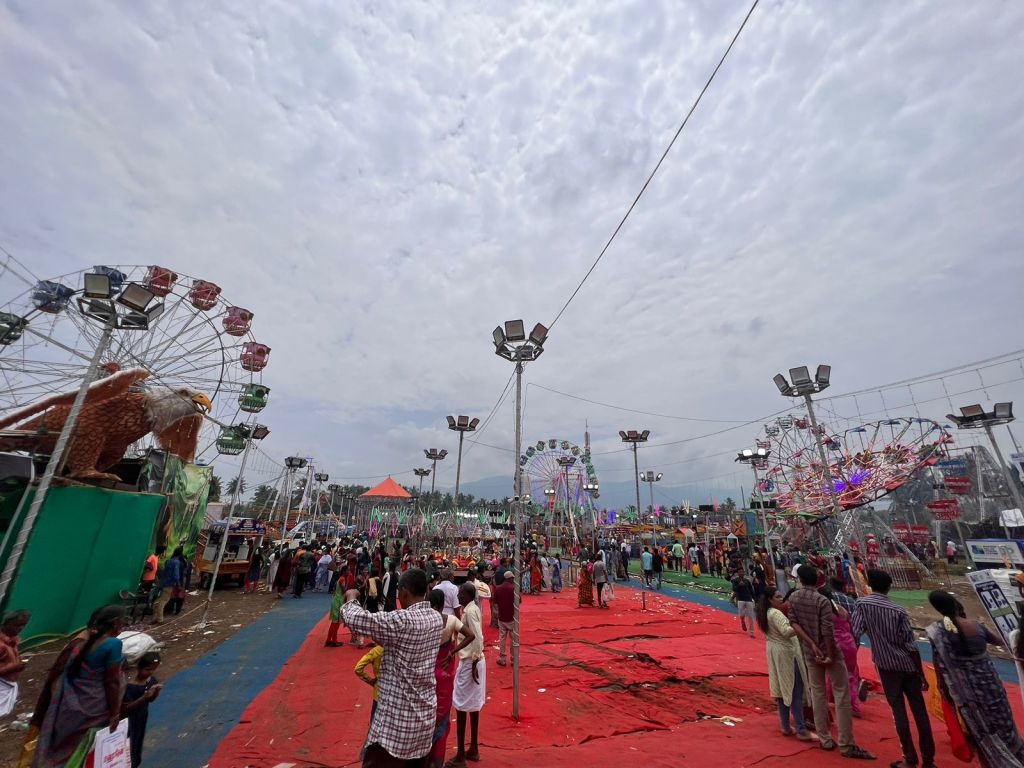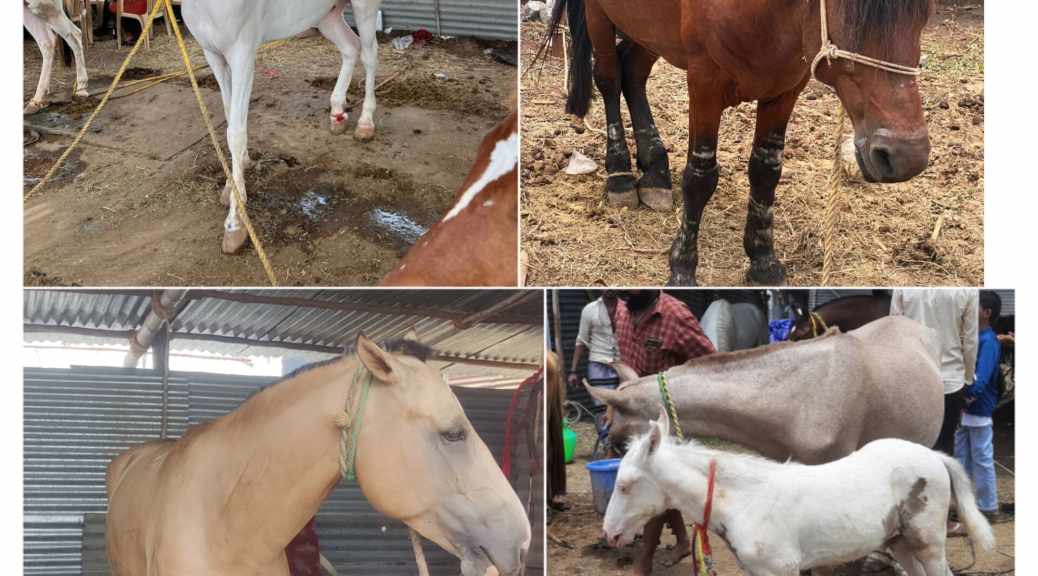When a friend mentioned taking a road trip to a fair at Anthiyur village, neither of us had many expectations. What can one expect at a village festival in India, after all? All that we had learnt before commencing our road trip was that it was a cattle fair, which was held as part of the annual festival of the Gurunathaswamy temple at Anthiyur village. Supplemented by a handful of YouTube videos in Tamil, we anyhow decided to take the long drive from Bangalore to spend a weekend.
We started from Bangalore before dawn to reach Anthiyur at the earliest and get sufficient time to see all the cattle stalls before returning. But only to our surprise, the scale of this temple village fair was anything beyond our imagination. Neither of us had seen or heard of a small village festival to be of such a large scale and spread.

Mythology of Anthiyur Gurunathar temple:
The story dates to around 600 years back, when there lived a clan near Pichavaram forest, that worshipped three stones known as ‘Kutty Aandavar’ (translates to ‘Small God’, in Tamil). The local ruler wanted to marry the priest’s daughter. However, the priest’s family was against the marriage proposal. Meanwhile, one of the members of the priest’s clan gets possessed by their deity’s spirit where the family is told to abandon the village along with the three prayer stones to avoid the outrage of the ruler’s anger. Following this, the family started to move towards north until they found a safe place to settle-down. At some point, the family felt that their survival was going to be difficult and that the stones being carried by them were an additional burden. Hence, they continued their journey by throwing the stones into a nearby pond. They halted at Anthiyur for the night.
On the following morning, Santhakumaran (one of the family members) was surprised to find the same three stones back in his bag. They realized the powers of their deity and resumed worship of the stones by giving them three different names. The first stone was called Kamatchi, second one was Perumal (Vishnu) and the last one was Gurunatha Swamy (a combination of Shiva and Kantha).
During the festival, three deities are taken on a procession from the main shrine at Anthiyur village to a temple in the nearby forest. As per mythology, a demon is believed to have had occupied the forest in which Goddess Kamatchiamman wanted to reside at. A fierce war was then fought between Veerabhadra (the warrior assistant of the Lord, protector of Kamatchi-amman) and the demon in which the demon eventually surrendered. It is said that instead of leaving the forest, the demon requested lord Gurunathar to allow him to stay there on a condition that Kamatchiamman came there once a year to visit him. However, Veerabhadra agreed to this on the condition that he too was allowed to stay in the same forest. This temple is today called Vanakovil (translates to ‘Temple in the forest’ in Tamil) where Kamatchiamman is brought in a palanquin from the main temple.
The history of the Anthiyur temple festival
The current temple structure is believed to have been built by the Pandya kings. The Gurunathar temple houses a 11*11*11 feet kulukai. A kulukai is a large earthen storage container mainly used for storing food grains, with a large opening at the top (to fill the container) and a small vent at the bottom (to take the grains out for consumption). It is believed that the kulukai in this temple is used to store the jewels and other items related to worship and are guarded by snakes. Only the head priest is allowed to enter the container and access the stored things and is unharmed by the guarding snakes. Therefore, this kulukai is worshipped by the local people and it is believed to keep them safe from reptiles, scorpions etc.
The month-long temple festival held during the Aadi month of the Tamil calendar hosts a range of unique rituals and celebrations during this time. Temple cars built for each deity are prepared and managed by respective caste of people. Two large towering nicely decorated temple cars (the largest is of Gurunathar swamy and the smaller is of Perumal swamy) are pulled by thousands of devotees who gather from across the nearby villages, from the main Gurunathaswamy temple to the Vanakovil and back. Today, animal sacrifice is practiced in Vanakovil.
The history of the Anthiyur cattle fair
A four-day long cattle fair is, however, the highlight of the festival for which people come from across districts of Tamil Nadu and states of India. There are only two cattle fairs held at this scale in India. First, at Anthiyur (more popular for the horse fair) and second, at Pushkar in Rajasthan (Primarily a Camel fair). The history of the ‘Kudurai Santhai’ (the Horse fair) dates to the times when Tipu Sultan was the ruler of Mysore. He visited this cattle market to buy the best horses for his cavalry and sold his horses that were no longer fit for battles.

It has over time gained popularity among horse enthusiasts across the country who consider buying horses from this market as a matter of pride and prestige. The cost of each horse can range anywhere between 50 thousand to 50 lakhs rupees. Today, apart from buying and selling horses at the ‘Kudurai Santhai’, many horse owners come here to simply display their prized possessions. One gets to see stallions, mares, sires, and ponies of various native indigenous and pure breeds here. Some horses are made to perform to drumbeats and kept on exhibition. On the last day of the four day long ‘horse fair’, Geegees are judged based on their structure, build, and looks and finally awards are given away. On the day we visited in 2023, there were over 1000 horses at the fair brought in for various purposes.
All accessories, equipment and other things that are associated with horse-keeping and equestrian training can be found and are sold here. Apart from horses, this fair is also the largest marketplace in India for other breeds of cattle and livestock like cows, goats, sheep, camels, rabbits, dogs, and birds. With encouragement given to native breeds, it is a great experience to see cattle across the 34+ acres of land.

Largest Makeshift Amusement Park:
To supplement the cattle markets, there is a makeshift amusement park set-up which also is by far the largest makeshift amusement park I have ever seen. Over ten giant wheels, rollercoasters, circus tents and at least three globes of death are set-up among several other types of amusement rides. The energy and ecstasy of this fair is all together only to be witnessed rather than to be read about.

Souvenirs bought:
- Bamboo staff- You will find people buying them, as it is considered auspicious to keep this weapon of Gurunthar Swamy, at home.
- Colorful horse whips
- Horseshoes- this is believed to absorb negative energy if hung at the entrance of houses.
Disclaimer: This article is posted with an intention to document folklore and lesser known festivals of India. If any mistakes found, it could be based on what was heard as stories. Kindly comment below or message directly for any corrections required.

